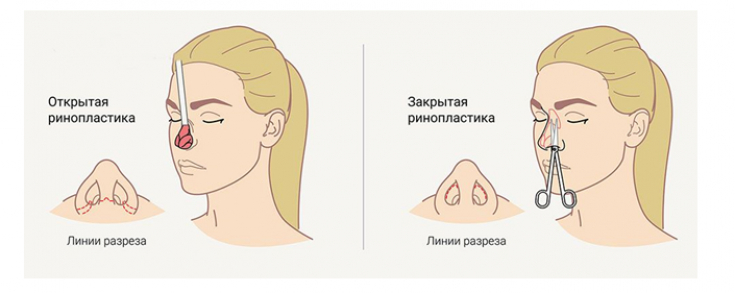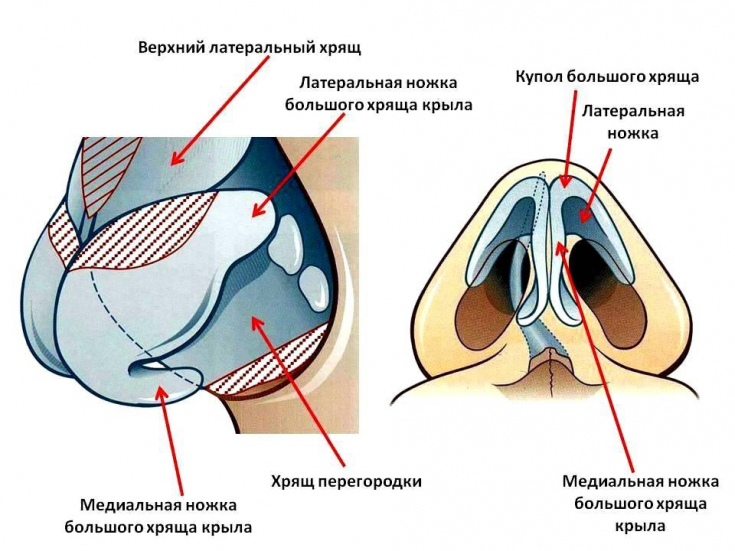Nose dorsum surgery should be based on a thorough preoperative analysis, including measurements of the nasion height, nasal tip, nasofrontal and nasofacial angles.
Osteotomy allows more bold manipulation in the area of the nasion up to the nasofrontal suture. The method of excision and removal of bone and cartilage fragments of the required size allows achieving objectively better results in rhinoplasty and, if necessary, correcting the nasolabial angle.
Read our article on estet-portal.com about the most current rhinoplasty techniques.
Current approaches to rhinoplasty
Recently, a lot of articles have appeared in the literature describing new approaches to rhinoplasty: options for rhinoplasty, a method for correcting scoliotic deformities, and dorsum plasty are presented in detail. But at the same time, there is incomparably little information regarding the formation of the proximal dorsum of the nose, the nasofrontal and nasofacial angles, which are of great aesthetic importance.
Follow us on Instagram!
Often, when forming the level of the bridge of the nose, the surgeon pushes away from the already modeled height of the terminal section of the nose, and its proximal level logically ends at the height of the existing nasion.
Intraoperative modeling of the nasolabial angle, which is associated with the separation of the nasal bones from the frontal bones, is perceived with caution by some surgeons.
According to A.D.Peipl, the bridge of the nose remains well balanced with only a well defined starting point of the nose at or just below the crease of the upper eyelid. The point of origin of the nose is defined as the deepest point of the nasofrontal angle. The line of the back of the nose goes from it to the highest point of the tip of the nose.
Injection rhinoplasty: practical tips and techniques for nose correction with fillers
Analysis of many works has shown that achieving an aesthetic profile in rhinoplasty – with the nasofrontal angle adopted by Europeans 115-1300 and nasofacial 34-400 – impossible without lowering the level of the root of the nose. In the practice of rhinoplasty, the group of patients with such parameters makes up more than 30% of the total number of operations performed. Therefore, one of the promising areas in rhinoplasty is the method of rhinoplasty with the possibility of forming the correct nasofacial angle.

Computer forecasting is considered to be an obligatory stage of preoperative analysis in rhinoplasty, which is performed on a large display at a scale of 1:1. This makes it easier for patients to perceive their image, and it gives the surgeon the opportunity to imagine the resection of anatomical structures in millimeters.
Otoplasty: methods for correcting combined deformities of the auricles
At the first stage, the degree of protrusion of the terminal section of the nose is agreed with the patient. The RLCrumley and R. Lancer method, based on the ratio of the protrusion of the tip of the nose to its length, and the RLSimons method, based on the ratio of the protrusion of the tip of the nose to the height of the upper lip, are used. At the second stage, it is necessary to determine the height of the nasion in order to form the most preferable nasofacial and nasofrontal angles. The delineation of the arch of the bridge of the nose will be performed between two simulated levels – terminal and root level of the nose.
Osteotomy options in rhinoplasty
Osteotome is a hollow rectangular chisel with 3 sharp cutting edges and one blunt end. The upper shelf is wider than the lower one by 0.6 mm on each side and has the shape of a trough, the bottom of which is beveled towards the upper edge of the tool. To perform the removal of a high hump, you can use both an osteotome and with small hump – rasp. In patients with a poorly pronounced nasolabial angle, rhinoplasty uses the METardy technique, which involves determining the upper edge of the resection of the nasal bones, then passing a thin osteotome 1.5-2 mm wide through the skin and separating the upper part of the nasal bones from the frontal bones using 2 approaches.
Key trends in modern correction of the periorbital area

Lateral osteotomy can also be performed in a variety of ways: incomplete osteotomy followed by a “green twig” fracture of the nasal bones, complete lateral osteotomy with significantly dilated nasal dorsum, medial oblique osteotomy.
Discussion of complications of osteotomy in rhinoplasty
Complications in most cases arise due to incorrectly performed osteotomies and are associated with the difficulty of controlling the depth of advancement of direct osteotomes under the skin in the area of the base of the pyramid and the root of the nose. "Step" in the root of the nose indicates resection of the thinner bone in the rhinion and insufficient resection of the thicker bone in the nasion.
Irregularities in the area of the back of the nose are associated with errors both in the resection of the osteocartilaginous hump itself and in the incomplete evacuation of cut off bone and cartilage fragments.
The reason for the front projection of the hourglass type is a "short", early oblique lateral osteotomy (from bottom to top) with insufficient frontal. The rectangular section of the bridge of the nose causes a combination of osteotomies (from bottom to top) plus medial oblique with insufficient frontal. Open nasal arch – consequence of excessive frontal osteotomy with insufficient lateral.
Autodermoplasty technique with perforated graft
In the analysis of the results of rhinoplasty of the nasal pyramid, the expediency of using a hollow osteotome has been shown. This technique does not contradict the principles of functional rhinoplasty, but at the same time, it can significantly reduce the percentage of complications.
Rhinoplasty is interesting because it has many surgical techniques and their combinations. The use of osteotomy, along with its safety, makes it quite easy to model the back of the nose and, if necessary, change the nasolabial angle.
Plastic clinic of modern technologies – path to beauty and perfection







Add a comment